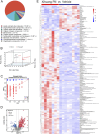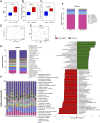Therapeutic potential of Xihuang Pill in colorectal cancer: Metabolomic and microbiome-driven approaches
- PMID: 39687297
- PMCID: PMC11646767
- DOI: 10.3389/fphar.2024.1402448
Therapeutic potential of Xihuang Pill in colorectal cancer: Metabolomic and microbiome-driven approaches
Abstract
Introduction: The Xihuang Pill (XHP), a venerated traditional Chinese medicine, has demonstrated significant anti-cancer capabilities. Despite its proven efficacy, the scarcity of comprehensive pharmacological studies limits the widespread application of XHP. This research endeavor seeks to demystify the therapeutic underpinnings of XHP, particularly in the realm of colorectal cancer (CRC) therapy.
Methods: In this study, mice harboring CT26 tumors were divided into four groups, each administered with either XHP monotherapy, 5-fluorouracil (5-FU), or a combination of both. The tumor growth trajectory was closely monitored to evaluate the effectiveness of these anti-neoplastic interventions. Advanced techniques, including 16S-rDNA gene sequencing and ultra-high performance liquid chromatography-tandem mass spectrometry (UHPLC-MS/MS), were harnessed to scrutinize the gut microbiota and serum metabolite profiles. Immunohistochemical assays were employed to gauge the expression levels of CD4, CD8, and Foxp3, thereby providing insights into the dynamics of tumor-infiltrating lymphocytes within the tumor microenvironment.
Results: Our findings indicate that XHP effectively suppresses the initiation and progression of colorectal tumors. The combinatorial therapy of XHP with 5-FU exhibited an enhanced inhibitory effect on tumor growth. Metabolic profiling revealed that XHP induced notable metabolic shifts, particularly impacting pathways such as steroid hormone synthesis, arachidonic acid metabolism, purine biosynthesis, and renin secretion. Notably, 17α-ethinyl estradiol and α-ergocryptine were identified as serum metabolites with the most substantial increase following XHP administration. Analysis of the gut microbiome suggested that XHP promoted the expansion of specific bacterial taxa, including Lachnospiraceae_NK4A136_group, Clostridiales, Desulfovibrionaceae, and Anaerotignum_sp., while suppressing the proliferation of others such as Ligilactobacilus, Lactobacillus_taiwanensis, and Candidatus_saccharimonas. Immunohistochemical staining indicated an upregulation of CD4 and CD8 post-XHP treatment.
Conclusion: This study delineates a potential mechanism by which XHP inhibits CRC tumorigenesis through modulating the gut microbiota, serum metabolites, and reshaping the tumor immune microenvironment in a murine CRC model. These findings contribute to a more profound understanding and potentially broaden the clinical utility of XHP in oncology.
Keywords: 5-fu (5-fluorouracil); Xihuang Pill; colorectal cacner; gut micobiota; untarget metabolomics.
Copyright © 2024 Zhang, Sui, Ma, Ma, Sun, Zhai, Cao, Zhang, Cheng, Li and Sai.
Conflict of interest statement
The authors declare that the research was conducted in the absence of any commercial or financial relationships that could be construed as a potential conflict of interest.
Figures









References
LinkOut - more resources
Full Text Sources
Research Materials

